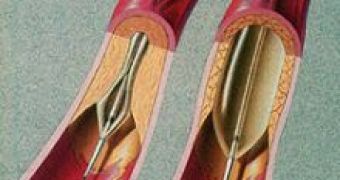Clogged blood arteries will no longer require days and nights spent in the hospital for continuous health condition monitoring. This is the result of a new study, which says that the patients who went home a few hours after the procedure is complete are exposed to the same risks as those who remain in the hospital overnight.
Balloon angioplasty of the coronary artery is a relatively new procedure, introduced in the late 1970's, which is accomplished with a small balloon catheter inserted into an artery situated in the groin region. When the balloon reaches the desired location, it is inflated to enlarge the narrowing in the artery. When successful, the procedure can relieve chest pain of angina and minimize or stop a heart attack.
Two complications can arise from this procedure: bleeding from the leg incision and reclogging of the heart artery.
In order to avoid the first complication, a team of Canadian researchers led by Dr. Olivier Bertrand used an artery in arm instead of one in the leg, which significantly reduced the bleeding.
The next step consisted in administering a single dose of anti-clotting drug and medically discharging half of the patients involved in the test, after 4-6 hours from the hospital. The other half benefited from the standard treatment: a single anti-clotting dose and a 12-hour intravenous one given overnight in the hospital.
After six months, the number of cases in which the doctors had to repeat the procedure due to complications was almost equal: 30 cases out of 504 among those who were treated using the first procedure, and 28 out of 501 among those who underwent classic treatment.
The combination of arm angioplasty and single-dose drug treatment "is extremely safe", Dr. Oliver Bertrand outlined.

 14 DAY TRIAL //
14 DAY TRIAL //